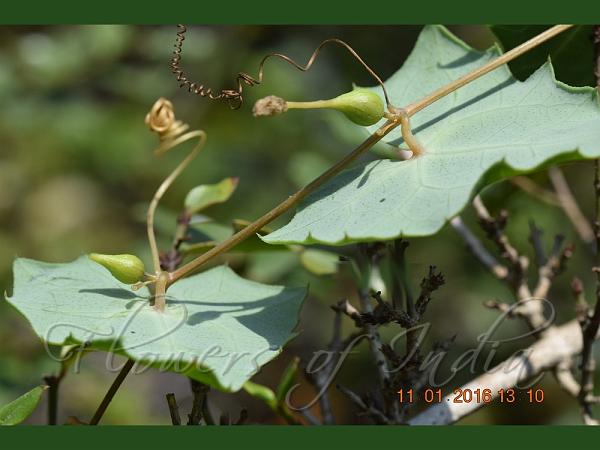|
| Creeping Cucumber |
|

|

|
|
|
|
Photo: |
Botanical name: Solena amplexicaulis Family: Cucurbitaceae (Pumpkin family)
Synonyms: Bryonia amplexicaulis, Bryonia solena, Cucurbita sagittata
Synonyms: Bryonia amplexicaulis, Bryonia solena, Cucurbita sagittata
Creeping cucumber is an extensive vine up to 6 m,
almost hairless; dioecious. Leaves are ovate or narrowly elliptic, 2.5-8 by 2-5 cm,
5-angular or deeply and narrowly arrow-shaped, base deeply heart-shaped
or arrow-shaped, tip rounded or pointed, often about 2 mm with a short sharp point,
margin remotely toothed, basal nerves 3-5, leaf-stalk 0.2-0.4 cm long.
Male flowers are borne on a 5-10-flowered condensed racemes, carried on
flower-cluster-stalk 1-2 cm long. Flower-stalks are 2-5 mm long, and in
addition collateral with the flower-cluster-stalk a solitary about 1 cm long stalked flower.
Male flowers are hairless except petals; bracts absent or linear, 1-2 mm long,
fugacious; receptacle-tube 3-4 by 2.5-3 mm; sepals about 0.5 mm long;
petals long-triangular, 1.5-2 by 1-1.5 mm, hairy at both sides; filaments erect,
2-2.5 mm long. Female flowers are solitary, hairless except petals;
flower-stalks 2-2.5 mm long; receptacle-tube, about 4 by 4 mm;
sepals as in male; petals larger than in male, ovate-elliptic, 3.5-4 by 2.5 mm,
with rounded tip, minutely pale hairy; style about 4 mm long, hairless;
stigma consisting of 3 prominent deeply dissected lobes. Fruit is ovoid,
1.5-2 by 1-1.5 cm, base rounded, at tip tapering into a narrow beak 6-8 mm long,
hairless; red and pulpy when ripe; fruiting flower-stalk 2-4 mm long.
Creeping cucumber is found in South India and probably NE India.
Flowering: May-August.
Medicinal uses: Creeping Cucumber has
traditionally been used in the management of diseases pertaining to
gastrointestinal, respiratory and vascular system.
Creeping Cucumber has
traditionally been used in the management of diseases pertaining to
gastrointestinal, respiratory and vascular system.
Medicinal uses:
 Creeping Cucumber has
traditionally been used in the management of diseases pertaining to
gastrointestinal, respiratory and vascular system.
Creeping Cucumber has
traditionally been used in the management of diseases pertaining to
gastrointestinal, respiratory and vascular system. | Identification credit: Rasingam L. | Photographed in Tamil Nadu. |
• Is this flower misidentified? If yes,